4 Design Trends That Will Define 2020
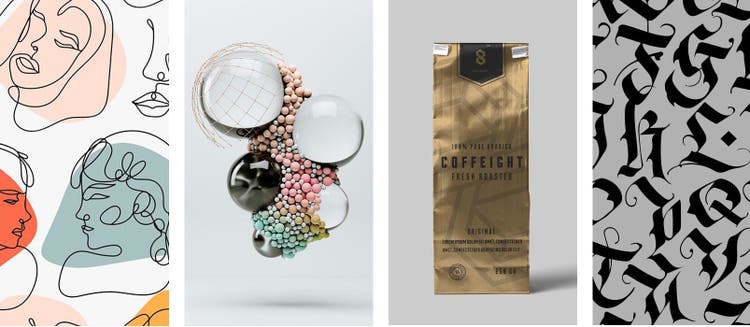
Image sources (left to right): Modern Abstract faces by Dariia; Abstract render with spheres by Javier Pardina/Stocksy; Metallic Coffee Bags Mockup by MrMockup; Handwritten Calligraphy Alphabet Set by Sergey Bitos.
Design touches everything we see and do. As we enter 2020, creatives of all types are finding that we need to work fluidly between many design mediums, channels, and tools to effectively communicate with a multitude of audiences.
From DIY to new takes on futurism, these trends are here to rock your year.
At Adobe Stock, we offer a platform for artists of all backgrounds and disciplines, working in mediums including illustrations, vectors, design and motion graphics templates, and 3D. We’ve long used our broad perspective and data access rooted in creative applications to offer deep insights about the Visual Trends ahead. This year, we’re taking that a step further, with the launch of our first-ever dedicated Design Trends outlook for 2020.
To surface the top trends having a monumental impact in the coming year, we’ve reviewed top searches, colors, fonts, designs, and projects that artists have made and shared on Creative Cloud, Adobe Stock, and Behance. Our seasoned teams of curators at Adobe Stock and Behance, led by our Creative Services trend forecasters, have added their wealth of experience in trend analysis and reporting to distill these top trends to know as we kick off the next decade of creativity.
Here’s our forecast for the design trends that will define 2020.
Handmade Humanism
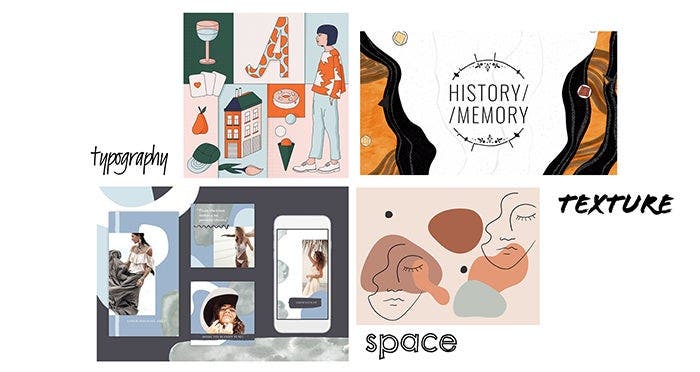
Image sources: Adobe Stock: Top left: Woman in a City by Lilly Friedberg; Bottom left: Cool Organic Instagram Story Set by You and I Graphics; Top right: History and Memory Title by M. Lomon; Bottom right: Elegant pastel illustration with linear shapes of a female face by IMR. Adobe Fonts: Top left: Kremlin Pro Regular by Paratype; Top right: Flood by Adobe Originals; Bottom right: Chelsea Market by Tart Workshop.
Organic illustrations, natural textures, and folksy fonts are some of the key elements of this trend, which has been favored by anyone from indie artists to people-oriented start-ups. The look is often defined by self-taught artists who bring a fresh, seemingly spontaneous and untutored style, and is known for its simplicity and authentic tone.
The emphasis on the handmade and individually crafted reflects a wider cultural shift toward the personal and authentic, according to Brenda Milis, creative services and visual trends principal at Adobe Stock.
“We’re seeing more and more DIY-type elements in design and visual culture in general, as artists strive to bring a personal touch to their digital work in a highly digitized world,” says Brenda. “This design trend is strongly related to the larger visual/cultural trend we identified, which we’ve dubbed ‘Express Yourself.’ This trend reflects a growing responsiveness to personal elements in design which resonate and connect with viewers.”
Nami Berglund, curator for Behance, also traces a connection between the rise of conscious consumerism and the handmade zeitgeist.
“If something is handmade, for example a piece of pottery or ceramics, that use of hands signals a rejection of mass production, of plastic, of garbage,” says Nami. “Many people have become so conscious of the earth and of waste — the tons of plastics that pollute our world and end up in the ocean.” The trend toward handmade design, she believes, is part of a groundswell of questioning our consumption.
Try it out
For brands as well as for designers, incorporating handcrafted elements helps create an approachable personality, and can be a genuine, effective way to connect emotionally with people.
To incorporate this trend into your work, add a bit of whimsy to your designs with hand-drawn shapes, patterns, 3D materials, and brushes using Adobe Capture. If you’re feeling romantic with your artistic expression, play around with traditional textures such as oil and watercolor brushes in the new Adobe Fresco drawing app.
Find more inspiration in our Handmade Humanism Collection.
Semi-Surreal
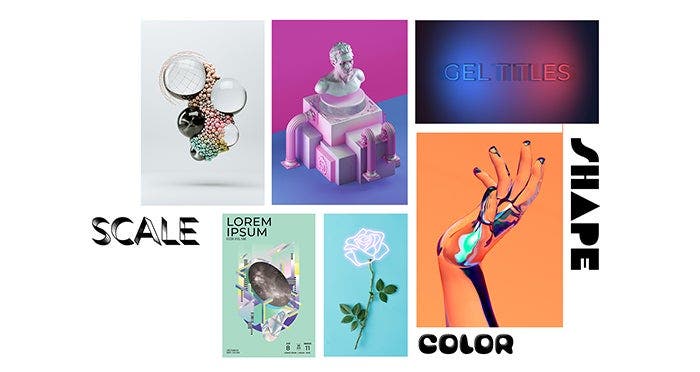
Image sources: Adobe Stock: Top left: Abstract render with spheres by Javier Pardina/Stocksy, Top middle: 3D rendering of still life with bust statue by Dmitry, Bottom middle: Futuristic Event Posters Set by Design Army, Bottom middle: Pink neon light rose sign, minimal flower concept flat lay by Zamurovic,Top right: Gel Titles by Wavebreak Media, Bottom right: 3D rendering of glass female hand by Katia. Adobe Fonts: Bottom left: Rig Solid Zero Halftone by Jamie Clarke Type, Bottom right: Bubblegum Pop Highlight by Device Fonts, Far right: Flegrei Regular by Adobe Originals.
Seemingly on the opposite end of the visual spectrum lies a trend we’re calling Semi-Surreal. Characterized by bright colors and unexpected juxtapositions, this kind of work is highly engaging in part due to the inclusion of intriguing tactile implications. While individual surfaces may appear hyperrealistic in their rendering, the overall effect is fantastical. In the world of Semi-Surreal, airy puffs of smoke coexist with neon-hued fur and sleek, polished planes in combinations that range from softly dreamy to eye-popping to mouth-wateringly candy-like.
Nami has another term to describe this trend: a “virtual vacation.”
“There’s a huge interest in immersive environments right now,” she says, pointing to several cultural obsessions that are reaching a fever pitch and show no signs of abating: virtual reality has hit the mainstream, Yayoi Kusama Infinity Room installations are drawing record-setting crowds, and retail shopping has morphed into a multisensory experience.
Nami posits that economic insecurity may be driving some of this hunger for fantasy. “The reality is that many people are struggling,” she says. “I think this trend has got a lot to do with current economics. People don’t get to escape from reality very often, and the best way to escape right now is digitally — the internet is right there in your hands with your mobile devices. Maybe you can’t afford to take that Instagram-perfect holiday, but you can drop in to a world of surreal fantasy through an experience, either in virtual reality, art installations, or shopping.”
The new Semi-Surreal design reflects the myriad of ways in which artists, game designers, retailers, and brands are seeking to serve this growing need. “It’s not just about fantasy,” says Nami, “but a fantasy of something magical, beautiful. This trend reflects a collective desire to remove ourselves from everyday ugliness.”
Try it out
Want to explore the Semi-Surreal design trend? Start by experimenting with gradients, glitter, and re-colorations of everyday objects using Photoshop’s advanced compositing tools. Create abstract compositions in Dimension by playing around with lighting, textures, and repetition with models balanced with neutral palettes to ground the visuals. Above all, let your sense of wonder and imagination be your guide.
Find more inspiration in our Semi-Surreal Collection.
Art Deco Updates
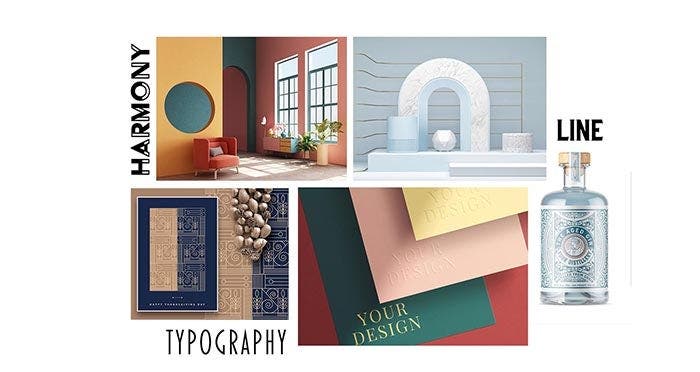
Image sources: Adobe Stock: Top left: Interior concept of memphis design by Jokiewalker; Bottom left: _Art Deco Greeting Card Layout by Polar Vectors; Mockup Podium 3D Render by nikolarakic; Bottom right: A4 Page Mockup with Shadows by Custom Scene; Far right: Vintage Liquor Bottle Label Set by Roverto Castillo. Adobe Fonts: Top left: Acier BAT Text Noir by Production Type; Far right: Gin Regular by Fort Foundry; Bottom left: Blakely Light by Mark Simonson Studio.
As we enter this century’s roaring ’20s, the familiar forms of Art Deco are making a comeback. This difference this time? Today’s Art Deco updates are decidedly not “retro”. Instead, they interweave a warm nostalgia for the previous century with a decidedly bold, futuristic look.
“In part, this trend is a response to the inescapable sleek, ‘flat’ design aesthetic we’ve seen, especially in our technology products for the past several years,” says Brenda. “I think people are hungry for flourishes, for more decorative elements, yet want to retain that modernity and sleekness.”
There may also be a more pragmatic trigger for the explosion of the updated Art Deco trend, says Nami: “I’ve been observing the rise of this more simplified iteration of Art Deco alongside the development of software tools. As software makes it easier to express shapes and materials like rippling water, gleaming metal, and smooth spheres, I find more designs incorporating these concepts. For example, I’m seeing more scenes with swimming pools, or sleek tiles.”
In addition to re-emerging influences of line art and Cubism in current graphic design, there are also references to the sleek Streamline Moderne movement in product, interior, and motion design, which reflect a famously forward-thinking era of innovation. The blocky layouts, geometric patterns, and metallic details in the Art Deco movement are now updated with a futuristic twist and play heavily with elevated typography.
Part of what updates this new Art Deco is its sophisticated, more relaxed color palette, which features swimming pool blue and soft pinks alongside brass and rose gold metallic hues. The softer, quieter colors may be a byproduct of the pervasive effects of social media on our lives, as more people purposefully blur the lines between public and private life, inviting their online friends and followers into their offices, bedrooms, and even their closets.
“Think about the popularity of Marie Kondo,” Nami says with a laugh. “One minute you’re watching her on TV, the next minute you’re buying rose gold hangers and thinking, maybe I ought to have a nicer, more Instagram-worthy closet!”
Try it out
The new Art Deco can add a layer of luxury to your creative projects in a multitude of ways. Add futuristic, metallic accents to express refinement to your designs. Use shadows and lighting to heighten the sense of drama or glamour. Experiment with perspective lines in patterns and search for new typography in the expansive Adobe Fonts library using the width and weight filters. An intimate, soft color palette keeps your designs from looking “retro” and brings them up to date.
Find more inspiration in our Art Deco Updates Collection.
Modern Gothic
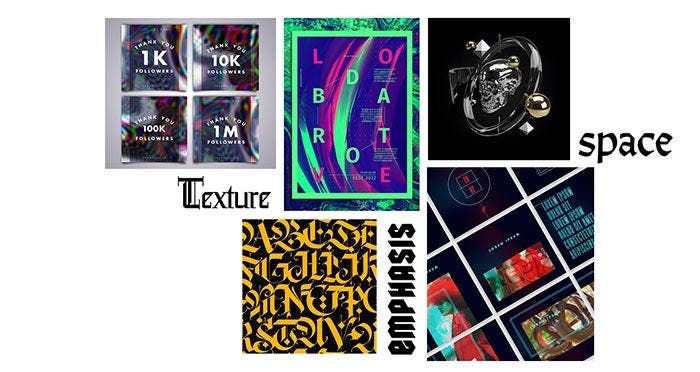
Image sources: Adobe Stock: Top left: Social Media Posts Set with Glitch Background by Wavebreak Media; Top middle: Abstract Dark Poster Layout with Colorful Neon Accents by Blackcatstudio; Bottom left: Pattern, ornament in the Gothic style by Ae; Top right: Black skull 3D rendering by Deniss; Bottom right: Futuristic Neon Social Media Grid Layout by Wavebreak Media. Adobe Fonts: Top left: Leather Light by Canada Type; Metalista Black by Suitcase Type Foundry; Bottom: Alexander Quill Regular by Canada Type.
The combination of futuristic materials, moody lighting, and striking typography makes this visual approach feel simultaneously old-school and visionary. Artists are creating interesting dichotomies between analog and digital elements, whether it’s references to graphics from the early days of the internet or cassette tape mock-ups with sci-fi designs. Darker palettes mixed with acidic color treatments make this trend feel theatrical, exciting, and special.
This blend of throwback and future-facing aesthetics is in some ways a logical product of our technologically enabled, information-rich times. With services and platforms like Spotify and YouTube, it takes only moments for younger generations to dig into the vast digital archive and unearth the edgiest or most popular music, films, and pop culture imagery of decades past. What once required dozens of trips to used record stores or libraries to find may now be revealed with a few clicks.
As an important strand of this trend, Cyberpunk design influences are coming to the foreground in the increasing use of glitch elements, plastic textures, and iconography circa 1995. This speculative fiction genre, comprised of a melange of film noir and cynicism in a high-tech future, was first popular in the 1980s and ’90s, with notable now-classic books like “Neuromancer” (by a father of the genre, William Gibson), and mainstream hit films like “Blade Runner” (1982) and “Hackers” (1995), and influential anime like “Ghost in the Shell” (1995).
1995 was a significant year in technology, bringing the launch of Amazon.com, eBay, Craigslist, JavaScript, not to mention the release of Windows 95 and the first DVD. While much of the modern internet was just getting started, the mid-’90s were marked by a widespread, hopeful utopianism as many people considered the potential positive impacts of new technologies on our lives, the promise of democratization of information, which many hoped would bring greater empathy and educational improvements for all. By contrast, cyberpunk fascinated by drawing attention to the frightening possible dark side of the tech revolution.
“When we were young,” says Nami, “we had a particular aesthetic when we envisioned the future. Now that generation of the ’70s and ’80s has grown up, and we’re revisiting that. In our youth, ‘futuristic’ meant new space stations, new technology, going to Mars. Today, TV shows like “Black Mirror” let you reimagine the setting closer to home…and it can get creepy! Pop culture like this explores the darker, near-future implications of the technology we’re now living with every day.”
Try it out
To bring the Modern Gothic aesthetic to your work, consider unexpected ways to play with dark and dramatic design. For example, practice working with smoke, shadows, and grunge effects in Photoshop. These effects can add depth and grit to your creative concepts. Add glitch or neon textures for a cyberpunk feel. To get a little more gothic, incorporate medieval or 3D assets with metallic objects and still life. Try the creative type features in Illustrator to craft daring typography on which to build your designs.
Find more inspiration in our Modern Gothic Collection.
If you’re working with these trends, we can’t wait to see. Share how you’re adding your spin on the trends with #AdobeDesign on social media. If you’re interested in becoming an Adobe Stock artist, sign up and take a look at the different guidelines for our range of asset types.
Stay with us throughout the year as we explore these trends further and see how artists are embracing them in their work on the Adobe Blog.
Don’t miss all of our in-depth creative trend coverage. Catch up on our 2020 Visual Trends launch, and check back for a deep dive into Motion Trends, and comprehensive explorations into each trend throughout the year.